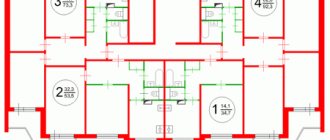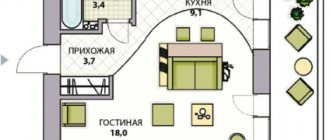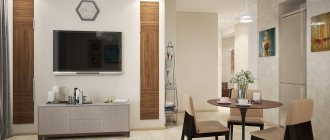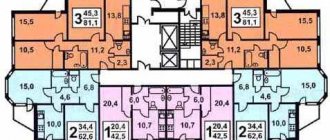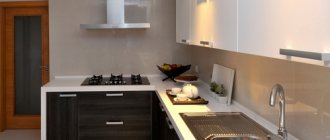One of the most common types of apartment remodeling is relocating the kitchen. This is understandable: often in an apartment there is enough “unused” space where it is quite possible to install kitchen equipment, and in return get an additional living room. In this article we will look at all aspects of moving and remodeling a kitchen. We talked about the simple combination of a kitchen with a room by dismantling the partition between them here. First, let's answer the most frequently asked question.
Apartment redevelopment - combining a kitchen and a room. Legal standards
The design arrangement of rooms in an apartment building is protected by law
The design arrangement of rooms in an apartment building is protected by law. Redevelopment or reconstruction of areas must comply with the requirements of SNiPs, SanNPiN, the Housing Code and a number of Resolutions approved by the Government of the Russian Federation.
- Housing Code. The document separates the concepts of redevelopment and reconstruction (Article 25). If the technical equipment of the apartment is affected, then the combination is considered a reconstruction. Repair work involving changes to the design in the field of construction is recognized as redevelopment. At the same time, the law obliges to make changes to the technical passport of the apartment, since when combined, the indicators of the quality of its area change: total, residential and useful.
- SNiP and SaNPiN standards. The requirements of documents 2.08.01-89, 31-03-03 (SNiP), 2.1.2.2645-10 (SaNPiN) are designed to protect the building, as well as the life and health of its residents, from the possible negative consequences of redevelopment and reconstruction. Based on these standards, a decision is made to permit or prohibit the consolidation of areas.
- Government resolutions. Legislative Act No. 47 (216.01.06) establishes the criteria for determining residential and non-residential premises. It also includes the grounds for recognizing houses as unsafe.
Separate legal documents on the requirements for redevelopment and reconstruction of apartments can be approved for regions of the Russian Federation (for example, No. 508, for Moscow 10.25.11).
Slab placement
The stove can be positioned so that the approach to it is comfortable and safe. This applies to both standard stoves and modern hobs.
There are several recommendations that are useful to familiarize yourself with before starting redevelopment.
- A gas hob or a separate stove should be placed at an interval of 50 cm from windows or doors. Moving the stove to the window is unacceptable. The prescribed distance cannot be reduced without permission. If a draft occurs, it can lead to the ignition of flammable objects or, on the contrary, it will extinguish the flame with the gas on.
- The stove should be located strictly near the gas distribution and ventilation compartment, with free access to the shutoff valve.
- If you are replacing a gas model with an electric stove, the wiring must be powerful.
- You cannot place a gas stove in the corner near the refrigerator - just like in any other place next to refrigeration equipment.
Refrigerator next to stove
The heat from the stove inevitably forces the refrigerator to work more powerfully. The warmer it is, the more cold the compressor produces. The device itself is technically designed for strict time intervals for auto-shutdown of the compressor. When external temperatures rise, the compressor literally works into overdrive to maintain the desired temperature.
As a result, equipment breaks down faster. And if the stove is on almost all the time, then even modern appliances break down ahead of time. On average, five years after purchasing a refrigerator, if it is operated next to a stove, fatal breakdowns occur. Repairs can be so expensive that owners think about buying new equipment.
Sink next to the stove
Many owners are sure that such a neighborhood is harmless, and even convenient, but this is not so. If you have an electric stove, then the border zone with the sink is always a risk of a short circuit. If you have a gas stove, there is a risk of explosion.
Also, do not discount burns to the skin and mucous membranes caused by boiling oil. If you are washing dishes and meat is being fried on the stove next to you, for example, then water that gets into the pan can actually cause a burn. The greater the distance between the stove and the sink, the more comfortable the cooking process.
Basic requirements for reconstruction/redevelopment
The kitchen and the room belong to different types of premises. There are several factors that hinder the combination of residential and non-residential rooms:
- Requirements for building design. By changing the design, demolishing walls and partitions, apartment owners can cause damage to the entire house. So the partition separating the kitchen and the room can be dismantled. It is prohibited to demolish main walls. If the wall is load-bearing, the law allows you to make additional openings in it, or expand the existing one. But only with the permission of the BTI and the installation of additional supports. The need to strengthen the wall and the location of the supports are calculated by technical specialists.
- Technical standards. When combining the kitchen with another room, it is necessary to comply with all technical standards. These include: fire safety requirements, sanitary regulations, requirements for heat exchange in the room, etc. It is strictly forbidden to change the location of the kitchen if the neighbors below have a living room at the place of transfer. This is due to the fact that the catering unit is a specially equipped room with high humidity. Work in the kitchen, as well as in case of accidents, can cause significant damage to the residents below.
- Communications. Regardless of which room the catering unit is combined with, this will certainly affect the communications located in the kitchen area. Even if they are not supposed to be dismantled and moved, they are often an obstacle to permitting redevelopment by housing commissions:
- the ban on redevelopment refers to the transfer of the catering unit to the living room, with the relocation of communications;
- It is easier to obtain permission to combine a kitchen and a room if the apartment has an electric stove;
- permission will be given only if the electric stove and sink are not planned to be moved, they must remain within the boundaries of the kitchen area (as their position is recorded in the project documents);
- If the stove is gas, combining the kitchen with the room is prohibited.
A few more important nuances
- Ventilation. It is required in the new premises, but moving it is the most problematic part. It is not advisable to move the kitchen if you have to pull the ventilation pipe more than 10 meters. The craving will decrease. Additional fans will be required. This is not the best idea for an apartment with a low ceiling.
It is also useful to read: Review of hoods for the kitchen without venting to the ventilation.
- Temperature conditions. Permissible temperature is 18-26 degrees Celsius. In cold weather – 19-21 degrees.
- The natural light ratio is also important. Its value is from 0.5. The new location must have sufficient lighting. It is not allowed to erect blind partitions that will block the window to the street.
- It is not recommended to carry the water supply far. This is fraught with a decrease in pressure due to the large horizontal extent. The pipes are hidden under the floor or in a drywall box.
- The cross-section of sewer pipes is larger than water pipes. Considering that they must run at a slope, the floor under which they are hidden will have to be raised. An idea for apartments with sufficient ceiling heights.
- It is worth taking into account the load of the electrical network and, if necessary, installing a separate machine.
Kitchen remodeling options
Among the options for combining a kitchen, the most common is combining it with the living room. Other solutions are possible:
- bedroom or other living room;
- combination with a balcony;
- corridor;
- increasing the kitchen area by adding storage rooms.
Is it possible to combine a kitchen with a room?
To understand what nuances you should pay attention to when planning to increase the kitchen area, you need to consider each in more detail. Is it possible to combine a kitchen with a room?
Combining the kitchen with the living room (living room or bedroom)
How to connect the kitchen with the room? The combination of a kitchen space with one of the three above-mentioned rooms is combined, since similar standards apply when implementing the project. Legal requirements regarding:
- procedure for demolition of load-bearing walls;
- lack of living space under the room;
- insulating the kitchen area if a gas stove is installed
The rules do not apply to one-room apartments. Such redevelopment is prohibited in them.
Combining a kitchen with a balcony
If you are planning to combine a kitchen with a balcony or loggia, the rules regarding the heat exchange of the building are added to the general requirements. By ignoring them, you can disrupt the technological state of the floor slabs.
Such a combination can lead to the gradual destruction of the building. In addition, according to the project, balconies and loggias are not insulated as thoroughly as residential premises.
Accordingly, heating consumption per combined area increases. Since typical designs are not designed for this, the heating system does not correspond to the additional load. Therefore, particularly stringent requirements are imposed on connecting a balcony to a kitchen. Technical standards:
- it is prohibited to expand the balcony opening in load-bearing walls;
- it is possible to expand the balcony block in apartments if they are located below the seventh floor in houses where the balcony block is built into embedded walls that are not load-bearing;
- In houses of any type it is prohibited to dismantle the door threshold of the balcony slab. This is necessary to preserve the external structure of the balcony and avoid freezing of the floor slab material;
- It is prohibited to bring heaters powered from the central heating system onto the balcony area;
- It is imperative to provide a transparent partition between the kitchen and the loggia (despite the fact that the laws do not directly prohibit its absence, in practice such a combination is considered a reconstruction of the building and a permit is not issued).
Relocating a kitchen on the ground floor or above a non-residential premises
The easiest way to do a redevelopment is when the apartment is on the first, second or third floors, and below there is a non-residential premises - a supermarket, a beauty salon, an office or a parking lot.
In this situation, you can move the kitchen almost anywhere, you can’t just move it to the bathrooms of the neighbors above. And this is an advantage of apartments on the ground floor, since for residents of all other floors there are restrictions on redevelopment, and moving the kitchen into the room is completely prohibited, since their kitchen will be located above the neighbors’ living room, worsening their living conditions.
This option affects ventilation, water supply and sewerage systems - you will need to call specialists to move communications. The most difficulties arise with the sewerage system, since it is necessary to lay communications from the sewer riser to the sink. Ventilation should be carried out from the kitchen niche to the ventilation duct in the old kitchen, and not to the nearest ventilation in the bathroom.
There is also a need for a technical inspection of the apartment to check the current state of all communications. Redevelopment requires a project, which can only be prepared by a licensed company that has SRO approval. For example, such as APM-1.
Coordination of redevelopment
Work should begin with obtaining permission
Whatever merger option is chosen, work should begin by obtaining permission. To do this you need:
- call a BTI specialist who will ensure that the apartment is in its original condition;
- find out from him the type of partitions (load-bearing or not), according to the building drawings;
- prepare a redevelopment project (in the BTI or in a private company with an SRO);
- obtain permission for its implementation (from the Housing Inspectorate, Management Company, fire inspectorate, gas service specialists).
Once all the documents have been collected, the redevelopment must be legalized at the Housing Inspectorate or through the MFC.
You can do this yourself, or you can entrust it to a design organization. These companies can not only prepare a redevelopment project, but also have it approved by all authorities. It is enough to provide them with a power of attorney for such work and pay for it.
Conclusion
Relocating a kitchen is a painstaking process that requires mandatory prior approval and the participation of many specialists. During repairs, you will need to contact the BTI, the Moscow Housing Inspectorate, the management company, and sometimes Mosgaz and Mosenergo.
Before starting the redevelopment, we recommend that you contact APM-1 for a consultation so that you have a clear understanding of what stages are important not to skip and what preliminary work in the apartment needs to be done in your case, because each redevelopment is individual.
Leave a request for a free consultation on apartment redevelopment
Zamyatin Dmitry Alekseevich
Zamyatin Dmitry Alekseevich
General Director of LLC "APM-1" Design workshop PEREPLAN.
Education: Higher technical (Master's degree from Moscow State University of Civil Engineering)
Specialization Coordination of redevelopment of commercial and residential real estate in Moscow and St. Petersburg
Reasons for refusal to approve redevelopment
If all conditions are met by the owner, the decision will be positive
Practice shows that the reasons for refusal are most often the same. Those whose project:
- does not comply with technical requirements and legal standards;
- did not receive approval from at least one interested service;
- contains errors in the provided documents.
If all conditions are met by the owner, the decision will be positive. When the housing inspection has approved the redevelopment, all that remains is to make repairs according to the project and call a BTI representative to check and draw up a new technical passport for the apartment.
Built-in household appliances
The modern market for household appliances offers a huge selection of all kinds of household appliances. Typically, equipment is divided into built-in and free-standing. To understand what the difference is, you need to take a closer look at each type separately.
In addition to the fact that the built-in oven looks more attractive, it is endowed with better heat protection. Manufacturers of such ovens make protection from external heat more reliable. Depending on the model and brand, heat-resistant cardboard or a layer of conventional insulation is used as insulation. Models with triple glass doors also play an important role in insulating heat from the external environment. Also, modern models are equipped with a fan and an emergency shutdown function, which makes the use of these devices safer.
An example of the placement of built-in equipment.
The built-in refrigerator is also not deprived of thermal insulation, thanks to additional finishing panels.
Thus, the thermal protection of built-in ovens and refrigerators allows them to be placed in the kitchen space the way the owner wants, without worrying about the safety of operation and serviceability of the appliances. If we rely on reviews from owners of built-in appliances, we can conclude that such devices are equipped with high-quality thermal insulation, which makes it possible to safely install household appliances next to each other.
This option for placing built-in equipment is quite acceptable
Advantages and disadvantages of kitchen remodeling
The advantages of increasing the kitchen area are obvious:
- the presence of free space allows you to accommodate more guests, as well as eat food with the whole family in comfortable conditions;
- due to the combination, the illumination also increases, since there are more windows in the new combined space;
- the inconvenience of cramped space when working in the kitchen is eliminated;
- While preparing food, you can simultaneously communicate with guests or family and count on their help when serving ready-made dishes on the table.
However, it is worth considering the disadvantages of unification:
- Smell. The aroma released during cooking will spread throughout the area of the combined room. This is not always appropriate and pleasant to others, for example, when preparing sharp-smelling dishes. The design of apartment buildings is not equipped with ventilation in residential premises, limiting it only to the kitchen and bathroom.
- Humidity. Boiling kettles and pots will invariably spread humid air throughout the apartment. This can lead to mold growth and damage to wall and ceiling coverings.
- Use of special materials during repairs. Considering the possibility of high humidity, as well as the spread of microparticles throughout the room, it is necessary to select special furniture, interior and decor items, and material for covering walls and ceilings.
- Noise. There is a high probability that the noise when working in the kitchen will interfere with your rest. In addition, do not forget about the sounds of operating household appliances that are equipped in the kitchen. For example: refrigerator, dishwasher and washing machine, mixers and meat grinders.
- Mess. Those who are ready to clean work surfaces immediately after cooking should combine the kitchen with the room. After all, such a mess cannot be hidden behind the door and left for later.
- Complex repair process. In addition to the fact that the unification work itself is very dirty, it will require coordination and approval of the result. It is this factor that often stops owners from implementing redevelopment projects.
If the complexity of the approval process does not bother the owners, and comfort and interior design are more significant, it is worth getting involved in the redevelopment of the apartment, combining the kitchen and room should be done according to the law.
Preparation of documents for redevelopment:
See also Telephone numbers for consultation May 12, 2021 Yulia Yurievna 1060
Share this post
Discussion: 5 comments
- Ulyana Makhova says:
06/08/2018 at 11:56A friend wanted to combine a kitchen and a living room in a two-room “Khrushchev” apartment, but she was never able to get permission, since she has a gas storage heater in the kitchen.
Answer
- Natasha says:
06/09/2018 at 00:24
You must obtain permission for this and draw up a project together with a specialist, but some people prefer to do everything themselves and do not inform anyone about it. It is very sad that few people know about the legality of such actions.
Answer
- Lyudmila says:
06/29/2018 at 07:21
Redevelopment is a thankless task, you have to weigh everything a hundred times - is it worth doing? And if you do not document everything, then you will not be able to sell such property later. The government is no joke.
Answer
- Anastasia says:
07/05/2018 at 23:37
Our neighbors combined a kitchen and a room. Gas stove. Who gave permission and how remains a question. I am against such redevelopments, against the demolition of walls in the apartment. If it is planned according to the project, it cannot be demolished. Even if it’s not load-bearing, what will happen to the house if everyone starts breaking down the partitions in the apartments?
Answer
- Sergey says:
03/06/2019 at 14:53
It is worth noting that, if a permit for redevelopment is issued, it is for a certain period, usually a year, so that upon completion of the repair work, the commission from the BTI will accept it. If the permit is expired, then it must be obtained again.
Answer
Size matters
If the task is to organize space in a large kitchen, the designer has a huge number of options open to him.
You can install the refrigerator the old fashioned way, as a separate element, without hiding it in the interior. The device will also look good in a corner, following the rules of Feng Shui.
If size allows, the kitchen can generally be divided into separate zones. In addition, refrigerators are built into furniture or, in special cases, under the stairs, thereby blending harmoniously into the surrounding environment.
With the right layout, a refrigerator in a small kitchen will look just as good. There are interesting options for how to decorate a small space.
How to legitimize reconstruction?
What documents need to be completed to carry out a legal kitchen remodel?
The main rule: first we agree on the project and only after receiving permission we begin work. Moreover, obtaining permission is no less difficult than carrying out the work. The algorithm includes:
- collection of documents;
- sending the prepared package for consideration by the commission of architecture and urban planning under the municipality. You will have to be patient: 30 days are allotted for the examination of upcoming work, submitted papers and making a decision;
- hiring a team of specialists and carrying out work according to the reconstruction/redevelopment plan.
Refrigerator next to the stove: truth and myths
This is why the forced proximity of a refrigerator and a stove is dangerous:
- Violation of the microclimate of the freezer. A working gas stove heats the wall of the refrigerator, as a result of which the compressor begins to cool intensely in response. The food is first defrosted and then cooled again. Such changes will lead to spoilage of vegetables, fruits and herbs.
- Reduced service life. Near a heat source, the device begins to work at its limit. The refrigerator will break down much earlier than it should. Models with refrigerants in the side walls will fail faster than others.
- Refusal of warranty repairs. The instructions for any device indicate that it should not be installed in close proximity to heat sources. Therefore, refusal to repair under warranty will be quite justified.
- Additional energy costs. If you place the refrigerator next to the stove, you will have to pay much more for electricity. The camera will start working 5-7 times more intensely.
- Unaesthetic appearance of the refrigerator. The wall of the refrigeration appliance adjacent to the stove will be constantly under the “sight” of drops of hot oil and fat. You will have to clean it regularly, after each cooking.
- Damaged parts. Due to excessive compressor operation, the plastic parts of the handles and door frames will melt, and the rubber seals will crack. This will affect the tightness of the unit - it will simply stop cooling effectively.
- Discomfort when using the stove. The burners will only have to be used on one side. The handles of the dishes will rest against the wall.
The idea that the freezer will become warmer next to a heat source and the food there will quickly spoil is a myth. Damage will indeed occur, but for a different reason, namely, as a result of uneven operation of the compressor.
Will hot food ruin your refrigerator?
Proximity to heating devices and oven heat is dangerous for the refrigerator. What happens if you put hot food inside it?
Temperature sensors are set to a certain value and the task of the entire system is to maintain these values. When hot food gets into the refrigerator (or freezer), the temperature inside increases sharply. The engine is forced to leave the operating rhythm and begin to work more intensively. This leads to more energy consumption. And with constant such practices, this will lead to rapid wear and failure of the system. For the same reason, you should not leave the refrigerator doors open for a long time.
In addition, hot products steam, and with sudden cooling, a large amount of condensation forms on the walls of the chamber, which will subsequently freeze and will also negatively affect the operation of the system.
Well, and a purely household aspect: dishes can burst due to sudden temperature changes.
obzorok.ru
